« December 2006 | Main | February 2007 »
January 30, 2007
e-mail jam
my e-mail is somewhat erratic at the moment, delays of up to a week. Apologies if you've e-mailed me and I haven't replied, I haven't got it yet...
Posted by john at 08:53 PM | Comments (0)
Drawing scribbles on the surface again.
Adrian Searle reviews Middlesbrough Institute of Modern Art’s opening exhibition DRAW in the Guardian.
Drawing raises its scratchy head whenever people try to justify art, like when they have to open a new art gallery. They see drawing as a measure of artistic ability. Let’s face it, there are precious few measures in art.
But just in case people think museums and galleries are getting choosy there is always a lot of this sort of “drawing”:
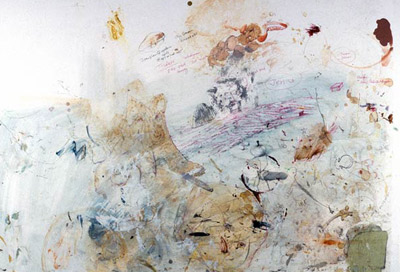
Tom Hooper
Which can confuse people. There’s nothing wrong with it – it’s expressive drawing, mark making at its most fundamental, but most people think of Objective Drawing when they think of drawing:
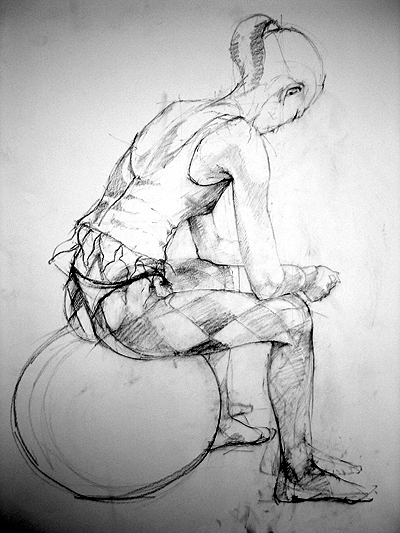
Harlequin, charcoal on paper, 840mm x 590mm
Posted by john at 02:18 PM | Comments (0)
January 29, 2007
Indigo - the Devils Dye
Indigo was a dye from the east which gradually took over from woad as the main source of blue in Europe in the 17th Century. However it didn’t have an easy time.
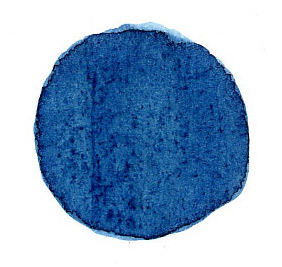
Originally indigo came from the sea snail Murex Trunculus, which secretes a mucus containing indigotin, which if collected and applied to cloth produces a deep rich blue hue. The Phoenicians were partial to this colour and would farm the sea snails to produce the dye. Considering that it took somewhere in the region of 60,000 snails to make a pound of dye, it wasn’t cheap. As a result rich blue clothes denoted a person of great wealth, and, some say, gave us the phrase blue-blooded.
Then indigotin was found in a plant, not coincidentally named indigofera tinctoria, native of South East Asia. But all was not well, fearing this ready source of blue dye would put the local dye workers - who used woad - out of a job, in 1654 the King of Germany pronounced indigo the Devil’s Colour and outlawed its use. Anyone found dyeing with Indian indigo was liable to get the death penalty.

Indian Indigo, photo: Evan Izer
Anyway, life being the way it is, Indian indigo quickly became the primary source of the dye up until the 20th Century. In fact the availability of indigo increased so much that the costs fell and the dyes ceased to tint royal clothes and ended up as the colour for work clothes. [Economists, I believe, have a lot to say about this sort of thing]
In 1897 the first synthesized indigo was produced by heating phenylglycine-o-carboxylic acid to 200°C with sodium hydroxide which produced a material that readily decarboxylates in air to form indigo. Anything that can readily decarboxylate has got to be worth six quarters of anyone’s money.

Not to be confused with Inigo who was a Jones, didn't come from the sub-continent, wasn't familiar with woad and was the First British Architect, generally responsible for Covent Garden, in London, amongst other things.
Posted by john at 10:11 AM | Comments (1)
January 26, 2007
Smalt
I’ve been at the smalt again. Mind you consumption is greatly to be avoided, coming as it does from ground glass, many a notorious poisoner’s poison of choice.

Jos, 2nd state, oil on panel 1800mm x 1220mm
Blue has been around for a while, initially fermented woad leaves from isatis tinctoria, were used as a dye, the same woad our ancestors used to anoint themselves with at times of heightened excitement.
These leaves were fermented in piss, and if there was alcohol in the piss the process was much more successful, so the dyers used to drink copiously on a Saturday, piss in the woad bath and leave the fabrics to soak all Sunday. [The resultant hangovers left us with the phrase Blue Monday, or Blauer Montag as Germany was the centre for woad dying in 16th Century Europe.]
Woad as a pigment was not much good for anything but ceremonial finger painting so artists started grinding up the gemstone lapis lazuli to form Ultramarine. This was a very expensive business and the paint was used very sparingly, for painting posh people's robes mainly.
When it came to painting large areas of sky Ultramarine was out of the question so smalt was used. Unfortunately the early methods of extraction were not very lightfast and have left us with many grey skies which would at one time have been blue.
I like its neutral tone, and I’m finding it an excellent background for the figure. Here's the picture pre-smalt, as it were:

Jos, 1st state, oil on panel 1800mm x 1220mm
Coming soon: Indigo – The Devil’s Dye.
Posted by john at 08:37 PM | Comments (0)
January 25, 2007
Another Bridesmaid

Pippy, 2006 digital image
Posted by john at 12:52 AM | Comments (0)
January 23, 2007
The Welder and the Bridesmaid
Just working on the photos from Wayne and Fran's fantastic wedding last summer, so if you're reading this down there in Australia-on-sea - I haven't forgotten.

The Welder and the Bridesmaid, 2006 digital image
Posted by john at 03:53 PM | Comments (0)
January 22, 2007
A fool abroad
Saturday morning is a good morning to sit in the cafe, leaf through the Guardian Review, and draw in the drawing book, dipping my finger in the dregs of the espresso...

a fool abroad, ink and coffee on paper
In the Review, Simon Schama waxes lyrical about Anselm Kiefer and his current exhibition at White Cube.

Kiefer, if you remember, is the artist with the Gabelstapler in his studio. His paintings are seven metres long, no wonder he needs a Gabelstapler.
Posted by john at 12:34 AM | Comments (0)
January 20, 2007
The Fuck It Point
The evolution of a piece of work – art, for want of a better word – is a complex business, whereby time and emotion act on the creative process. If I plot the progress of a painting or drawing, mathematically, with all that x axis and y axis stuff, where x = time and y = the quality of work, we get:

where this is a small drawing I did on the corner of a drawing being undertaken by a student studying the Dark Art of Drawing.
The work begins and there is an immediate, if imperceptible, improvement on the blank paper due to the fact that there are now marks upon it. But as time progresses, as only time can, the marks get more and more complex [and there will no doubt be mathematical equations to illustrate this, I shall let you know when I have discovered them]. This complication can lead to despair as the artist loses sight of the process, begins to worry too much about the product and the quality starts to go down hill.

This is inevitable, and as an artist you have to be prepared for it. But sadly sometimes, because you are an artist, you are not prepared for it – being an artist and doing art can often be mutually exclusive, such is the creative life.
Anyway, if you can steel yourself for this sharp down-turn in events at about x + 30 [maths again you see] then you can turn this to your advantage. Rather like Dante entering the Gates of Hell, you must needs abandon all hope at this point. For this is the Fuck It Point. The point after which nothing is ever the same again. The point after which nothing really matters. The point after which things really begin to take shape, because you've let go the left brain and given free rein to the right side.
But beware, if you hit the Fuck It Point at around x + 90 there is a chance that you have got so much down and become so close to the work that rage and fury take over, things get out of hand and mugs start flying.
Posted by john at 09:54 AM | Comments (0)
January 18, 2007
Today's hat
Today I had buying of parts,
Tomorrow I shall have filming of drama,
Yesterday I had photography:
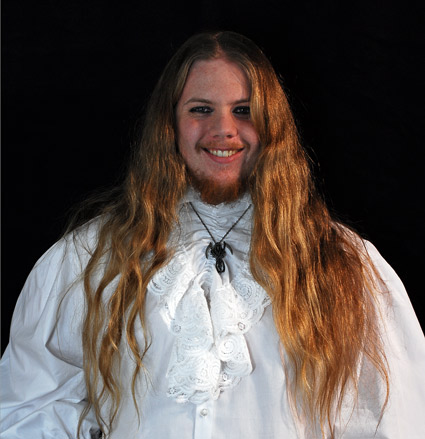
The hats are flying through the air.
Posted by john at 10:20 PM | Comments (0)
January 16, 2007
Overpainting

While the underpainting in the foreground is drying I overpaint the underpainting in the background. Soon it will be time to overpaint the underpainting of the foreground and perhaps scrape back the overpainting of the background to reveal the underpainting. Then, when that’s over, I’ll paint the underpants of the model.
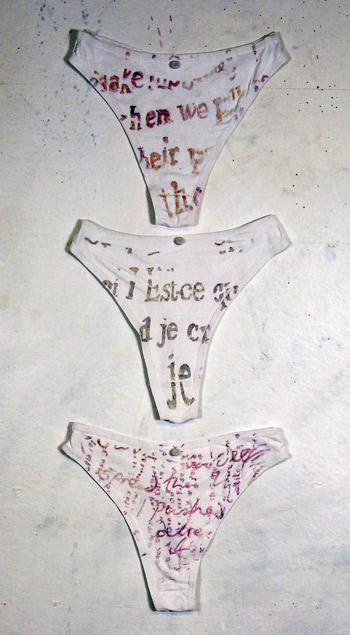
Posted by john at 11:48 PM | Comments (0)
January 15, 2007
Underpainting II
A day spent slapping paint about. Getting a lot of the stuff onto the panel in a vague approximation of shadows and highlights. Underpainting is always quite extreme, it creates more possibilities later on.

I let the Flake White down with linseed oil, which makes it very slippery and runny. Unfortunately it dries with a sheen which I don’t like, and it’s very difficult to photograph. Can’t spend too long pushing the paint about when it’s like this or it gets all streaky and messy, too messy.

Also limited my palette to Indian Red and Flake White, oh and some Unbleached Titanium Dioxide. There was a bit of Burnt Umber and Prussian Blue lurking down the dark end of the palette which had to be fenced off - if Burnt Umber gets involved with the Flake White everything goes Beige, an event to be avoided at all costs.
Posted by john at 12:29 AM | Comments (0)
January 13, 2007
From drips to Dogma
I spend as much time on the backgrounds as on the figure, sometimes more I guess. The background is a contradiction. I want it to look effortless and timeless, I want it to look as if it is incidental to the subject, when in fact it is vital. This takes a lot of work. It’s amazing how much work goes into making something look like no work has gone into it.

The brush strokes in the backgrounds are part of the energy, they are often an escape valve for me when the brush strokes in the figure are confined to certain forms. I use the direction and energy of the brush strokes to define the background, just as I use them as such for the figure, or as much as I can – it’s a fight in the figure. I have to keep reminding myself that the brush is just a tool to get various amounts of paint onto particular areas of the panel to achieve certain effects.

I use big brushes because it hampers my innate sense of order. I make it so I physically can’t get the paint on to the degree of accuracy I want, because I feel it is the attempt that is important, and the success or failure of the attempt can be left as evidence of my intent, my passion if you like.
It is a process I’m undertaking not a picture I’m making. The picture is the result of my attempts, both my successes and my failures, to convey feeling and emotion. These are perhaps Dogma pictures, if I may borrow from Lars von Trier and Thomas Vinterberg’s manifesto.
Posted by john at 02:41 AM | Comments (0)
January 11, 2007
Happy Birthday!

M. Picasso’s Les Demoiselles d’Avignon is 100 years old today. Jonathan Jones discusses its continued relevance in the Guardian.
Posted by john at 08:21 PM | Comments (0)
January 10, 2007
Four feet


wonderful things, feet.
Posted by john at 10:55 PM | Comments (0)
Many many years ago
Rooting through the racks, towards the back, amongst a stack of portraits, I find my first love.

For many years I tried to paint Gill's portrait, and for many years I was not up to the task. Then eight years ago, as I began to enjoy the oil paint, I managed to capture some of her quiet beauty.
Posted by john at 12:43 AM | Comments (0)
January 09, 2007
still drawing, mostly
Drawing with paint is good because you can fuck around with the lines. Smudging them, rubbing them, extending them and generally getting them to do things ordinary drawn lines won’t do.

Some lines are in fact edges which is starting to get towards painting as oppsoed to drawing. This is all preparation for The Big Push, when large amounts of paint get turned out onto the palette and then slapped onto the panel. I like to do the next stage in one go, from top to toe, which with a panel some six feet tall takes some doing.
Colours here are fluctuating between Burnt Umber and Prussian Blue – nothing new there then. I think there’s a bit of Indian Red creeping in too. For those who have followed the links to Michael Harding’s excellent hand made paint, note the common theme in the properties of these pigments? Very Fast Drying – ideal for underpainting like this.
Posted by john at 12:21 AM | Comments (0)
January 08, 2007
Some Thoughts on Painting
“The painter makes real to others his innermost feelings about all that he cares for. A secret becomes known to everyone who views the picture through the intensity with which it is felt. The painter must give a completely free rein to any feelings or sensations he may have and reject nothing to which he is naturally drawn. A painter must think of everything he sees as being there entirely for his own use and pleasure”
Lucian Freud, Some Thoughts on Painting 1954
Posted by john at 10:35 PM | Comments (0)
Paint and Energy
It’s not the painting[1] that matters, it’s the energy behind it.
For me the energy needs strong foundations. I want the picture to describe the power and energy [and beauty] of the subject, so I need to get the form down as best I can before I start letting go with the paint. Most of my large panels start off like this - with drawing.

Semantic pitfalls and the shortcomings of our language:
1. painting, v., the act of applying paint.
2. painting, n., a picture
Posted by john at 06:29 PM | Comments (0)
January 06, 2007
Revolution on the palette
To get in amongst the figure I made a radical change to the background. See previous post then set about the highlights.
It was all drippy, runny, very wet paint, Titanium White and Cobalt Blue in the back ground, Titanium White and Indian Red on the figure, with a bit of Burnt Umber for some darkness.

and a different brush for every hue and tone.
Posted by john at 12:28 AM | Comments (0)
January 03, 2007
dusttodust
When I got the grant from the Arts Council to start the project titled Becoming Unstuck, and indeed start these very diaries, I worked with models and projected text.
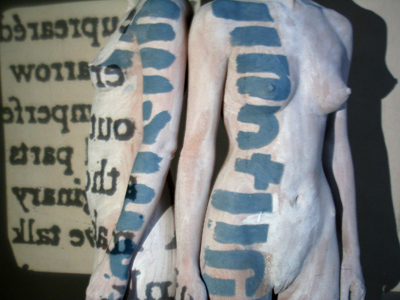
This led to the idea of a dance piece with text. That was 2004, this is the first piece of dance for camera:
It should be 16:9, widescreen, and indeed is in other media, but due to circumstances beyond my control it has come out on YouTube as 4:3.
Big thanks to Rachel Brooker for the beautiful dancing and Darren Durham, aka FortDax, for the fantastic music.
Posted by john at 07:08 PM | Comments (0)
Onward and Upwards
Now I’ve got the tops off the tubes of paint I must needs get the crowbar out and try to get the lid off a box of confidence.
Then set about this painting:

I’m still just fiddling about in the background, why am I so terrified of getting into the figure?
I’m wrestling with two elements: drawing and painting and just to confuse matters: drawing with paint. Drawing and painting are different states of mind, different approaches to mark making. Painting uses the light and considers planes that go to make up form, whereas drawing deals with shadow and works with lines to create shape. Drawing with paint is just fucked up, but can be used to great effect nonetheless.
Posted by john at 03:07 PM | Comments (0)